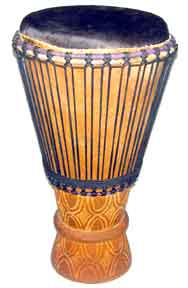
The Bougarabou
part of the Membranophone family
KEN CRAMPTON
SEE OUR SELECTION OF BOUGARABOUS
The Bougarabou no doubt hails from West Africa, but what is elusive where
does the name come from? Similar to the Djembe, the name for this drum seemed
to appear and spread like wild fire. The names for drums often differ depending
the regional differences. The Bougarabou has spread to carver’s around
West Africa, as for its modern name it probably comes from the Ivory Coast
or Senegal. Older versions of the Bougarabou can be found in museums around
the world, depending on who and where they were collected, the names once
again blur, and we then must decide is it the shape, and materials that define
a drum? I say yes, and do you use a name prescribed by a museum that collected
this drum from a tribe or village long ago or a name defined by the the modern
day exodus of drum traders? Its these drum traders that help spread the name,
and sometimes the lore of the drum.
We begin first with one of the most common shaped and worldly present drums
besides the frame drum would be conical / barrel shaped drums, often covered
in a thicker skins usually a cow, antelope or horse / donkey. The means of
affixing the hide to the drum is often pegged (similar to Sabar, whose home
is Senegal) or tacked to the shell, other methods like slicing the hide creating
strands (similar to traditional Bata, whose home is Yoruba), then in modern
day, rope / rocket cord is used. The unique shape that defines the Bougarabou
is it’s conical shape that “skirts” around the bottom of the
the shell. Depending on the various regions, the “skirt” could be
higher on the shell of the drum, or perhaps, decorative carvings, sometimes
descriptive representing body parts, or geometric shapes. Some of the earliest
representations of the bougarabou are found in museums that say these drums
come from Cameroon, Nigeria, Ghana, Senegal, Gambia, and Guinea. Early Bougarabou
bear a likeness to Ngoma Drums, and Vodou Drums. In recent drum shell “genealogy”
I have found that Senegal carver’s have created Bougarabous with the
“skirt” of the shell depicting women’s breast, and another
version which resembles the goblet shape of the Djembe that make the stem
of the shell bulb like. The wood used in Senegal is dense, and heavy, with
a red and gold tint.... this same wood is used for making the Sabar and Djembes.
The Ghana Bougarabou (Lark in the Morning calls it a Rasta Drum) is made of
the lighter wood bathed in palm oil and has a ring around the stem for its
“skirt”, this ring is usually 1/3 the way up the drum shell. The
Ghana Bougarabou is often headed with goat skin. The most renowned Bougarabou
makers of today would be the Ivory Coast !! A darker wood, reminiscent of
the wood from Mali, even the geometric patterns bear a likeness to the carver’s
of Mali. These have a THICK cow hide with the hair still on the drum.
The Bougarabou is played and sold in sets of 3 or 4, I am still looking for
the names to the different sizes. In Tom Klowers book “The Joy of Drumming”,
he states that they are played in sets of 4, backed by the women playing simple
rhythm on pieces of wood. Which is the way Thione Diop played at the Seattle
Rhythm Festival last year. The Bougarabou has a rich conga type sound, and
is played flat on the ground for playing sitting, or leaning on a stand where
the player is standing. In the liner notes from Saikouba Badjie “Bougarabou:
Solo Drumming of Casamance”, “Bougarabou (boo-GAR-a-boo) drumming
accompanies all Jola dance....Before this century, the Jola played just one
drum.... with the hand and a stick...” Multiple drums appeared in the
early in this century, then in the 70’s the third and fourth drums were
added, because of the influences of Cuban Salsa Music. It goes on to say that
“traditionally” there is only one drummer, only the most experienced
drummers use four drums, and he is accompanied by the village in song, clapping,
and the Dance Circle.
To theorize, if the Jola is the oldest bougarabou village located in southern
Senegal below Gambia and near the coast of Guinee, when colonization of the
West Africa and the slave trade spread through the world in the 1800’s
the slaves took their spirit an knowledge with them. Now imagine Haiti....a
slave population from Senegal, Guinea, and Gambia.... Here through worship,
and more ritual, a rhythmic culture explodes in music, faith, and the arts.
The Vodou have many murals painted in churches, and sacred spaces, depicting
what looks like Bougarabous, played in ceremonies, and festivities. These
drums, still made today, are even pegged and tied a similar manner as the
Bougarabou of the Jola. Now in Brazil, there are these three to four drums
that are played together called Atabaques these are shaped similar to the
Bougarabous, but they are coopered barrels, and have modernized hardware that
is threaded similar to congas.... Humnnnn..... Then there is the Ashiko...
A conical shaped drum made today by drummers who are making their first drum....
We might be able to say the Bougarabou could be the mother of the modern day
Conga’s and Ashiko’s.....
Food for thought........




